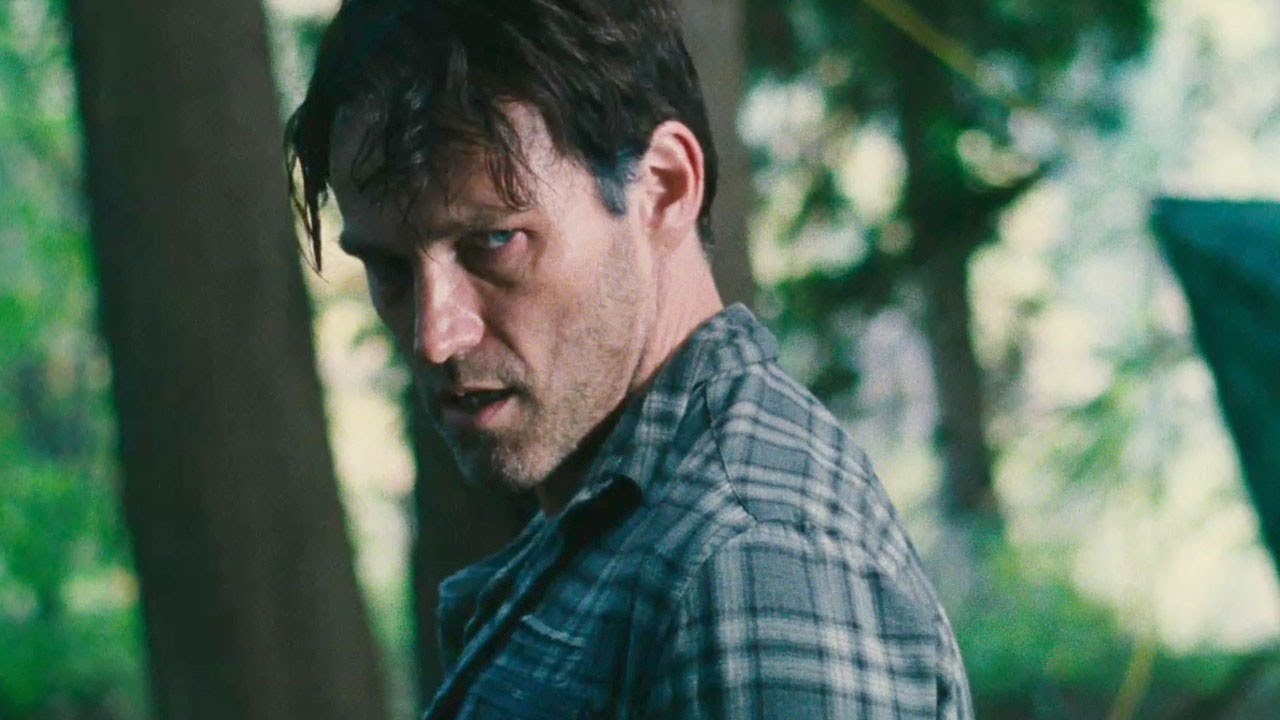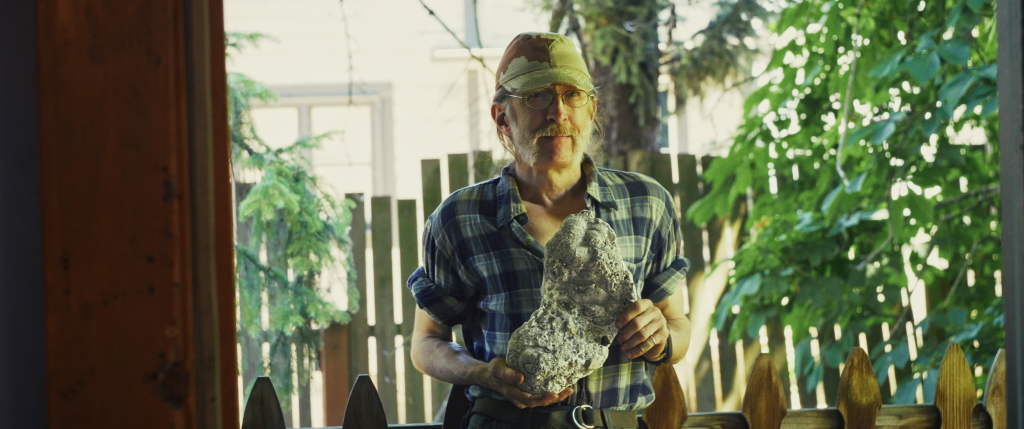Reviews
‘The Barrens’ Review: A Devilish Disappointment

Darren Lynn Bousman quickly gained a following within the community in a way many filmmakers don’t. Bousman came out of the gates strong with his direction of Saw II, III, and IV. His Saw tenure was followed by his instant cult classic Repo! The Genetic Opera (not written by Bousman). The man could do no wrong! From there, he made waves with Mother’s Day (also not written by Bousman). And that’s when it started to go downhill. 11-11-11 was a mess that burned fans of Bousman. Alleluia! The Devil’s Carnival (not written by Bousman) failed to hit that same core audience that fawned over Repo!. And that’s when he made his Jersey Devil film, The Barrens.
The Barrens: A Family Camping Nightmare
Richard Vineyard (Stephen Moyer) takes his new wife, Cynthia (Mia Kirshner), and his children, Sadie (Allie MacDonald) and Danny (Peter DaCunha), on a weekend camping trip to the Pine Barrens. What’s supposed to be a lovely weekend away from life and work quickly turns into a battle of life and death. Richard seems off from the start and only gets more…quirky as it goes on. Does the Jersey Devil truly exist, or is the Jersey Devil nothing more than a conduit for the horrors committed by man?
The Barrens is written and directed by Darren Lynn Bousman, and it starts strong. Richard is desperately trying to keep his family together while suffering from an unknown condition. Cythnia is actively trying to have a relationship with her teenage stepdaughter without pushing too many boundaries. And poor Dylan just wants to be happy. Bousman’s story setup is excellent. The only big plot hole in the story is (as someone who spent a majority of their life growing up in Philadelphia) that people from Philly don’t typically go to the Pine Barrens to go camping. (That’s kind of a joke, kind of not.)
Why The Barrens Fails: Visual and Character Missteps
To accurately discuss why this film is awfully conceived, we need to get into some spoilers. Before we do that, we need to talk about how plain of a film this is. The Barrens takes no visual risks. You’d think the person who directed the visually stunning, wild transition-filled Saw II, III, and IV would be able to do something visually interesting with this woods-based horror film. You’d be wrong. Bousman’s direction fails in two specific ways. First, his visual direction is nothing more than point-and-shoot. Second, his character direction is, “make faces so the audience knows something is wrong.”
Stephen Moyer is an incredible actor (on True Blood). It seems that Moyer has taken the wrong lessons away from his tenure with the HBO property. While the constant brooding and sullen acting style works for Bill Compton, it does not for Richard Vineyard. Moyer’s performance is distractingly one-note. At least he gets to use his actual accent.
Jersey Devil Horror
The entirety of the film plays off the question of whether or not the Jersey Devil is real. Richard’s dwindling mental capacity is the focal point of the film’s horror. A neighboring camper goes missing the same night that Richard wakes up randomly in the woods. Richard’s realistically bizarre waking nightmare accompanies this. Bousman attempts to make the audience question whether or not Richard is committing these atrocities, if the Jersey Devil is committing them, or if Richard is committing them at the behest of the Jersey Devil.
SPOILER ALERT
I would have forgiven many of the film’s faults if they had taken the direction of Richard being nothing more than a sick individual with a weird fascination with the Jersey Devil. Rather than going with a more grounded approach, Bousman does one final “twist,” and we learn that not only is the Jersey Devil real, but it’s what caused all of these murders. Why was Richard acting so off, you may ask? He has rabies. RABIES. Are you kidding me?
Bousman slaps the audience in the face with this reveal. It’s beyond lazy and adds insult to injury to the audience who stuck with this awful film thus far.
Skip This Jersey Devil Flop
As much as I love cryptids, they’re our version of the Brothers Grimm. Creatures like the Jersey Devil, Mothman, Loch Ness, and the Squonk are nothing more than attempts to keep younger people out of the woods or inside by the time the streetlights come on. It’s a darker version of Santa Claus. The Barrens feels like Darren Lynn Bousman was too afraid to try and make a film with a deeper point; sometimes the monsters are the people we would least expect. Stay away from this film if you have any interest in Jersey Devil lore. You’ll be sorely disappointed.
Reviews
‘Frankenstein’ Review: Guillermo Del Toro Is Off to the Races

Those expecting Guillermo Del Toro’s Frankenstein to be similar to the book, or to any other adaptation, are in for something else. A longtime enjoyer of the creature’s story, Del Toro instead draws from many places: the novel, James Whale’s culturally defining 1931 film, the Kenneth Branagh version, there are even hints from Terence Fisher’s Curse of Frankenstein, and if the set design and costuming are to be believed, there are trace elements of the National Theatre production too.
The formulation to breathe life into this amalgam is a sort of storm cloud of cultural memory and personal desire for Del Toro. This is about crafting his Frankenstein: the one he wanted to see since he was young, the vision he wanted to stitch together. What results is an experience that is more colorful and kinetic and well-loved by its creator than any Frankenstein we’ve had yet, but what it leaves behind is much of its gothic heart. Quiet darkness, looming dread, poetry, and romance are set aside as what has been sold as “the definitive retelling” goes off to the races. It’s a fast-paced ride through a world of mad science, and you’re on it.
Victor Frankenstein’s Ambition and Tragedy
A tale as old as time, with some changes: the morbid talents and untamed hubris of Victor Frankenstein (Oscar Isaac) guide him to challenge death itself. Spurred by a wealthy investor named Henrich Harlander, and a desire for Harlander’s niece Elizabeth (Mia Goth), Victor uses dead flesh and voltaic vigor to bring a creature to life. His attempts to rear it, however, go horribly wrong, setting the two on a bloody collision course as the definitions of man and monster become blurred.
Guillermo Del Toro’s Frankenstein is more Hellboy in its presentation than it is Crimson Peak; it’s honestly more similar to Coppola’s Dracula than either of them. The film is barely done with its opening when it starts with a loud sequence of the monster attacking Walton’s ship on the ice. Flinging crew members about and walking against volleys of gunfire, he is a monstrosity by no other name. The Creature (Jacob Elordi) cries out in guttural screams, part animal and part man, as it calls for its creator to be returned to him. While visually impressive (and it remains visually impressive throughout, believe me), this appropriately bombastic hook foreshadows a problem with tone and tempo.
A Monster That Moves Too Fast
The pace overall is far too fast for its first half, even with its heavy two-and-a-half-hour runtime. It’s also a far cry from the brooding nature the story usually takes. A scene where Victor demonstrates rudimentary reanimation to his peers and a council of judges is rapid, where it should be agonizingly slow. There’s horror and an instability in Victor to be emphasized in that moment, but the grotesque sight is an oddly triumphant one instead. Most do not revile his experiments; in fact he’s taken quite seriously.
Many scenes like this create a tonal problem that makes Victor’s tale lean more toward melodrama than toward philosophical or emotional aspects; he is blatantly wild and free, in a way that is respected rather than pitied. There are opportunities to stop, breathe in the Victorian roses and the smell of death, to get really dour, but it’s neglected until the film’s second half.
Isaac’s and Goth’s performances are overwrought at points, feeling more like pantomimes of Byronic characters. I’m not entirely convinced it has more to do with them than with the script they’re given. Like Victor working with the parts of inmates and dead soldiers, even the best of actors with the best of on-screen chemistry are forced to make do. The dialogue has incredibly high highs (especially in its final moments), but when it has lows, how low they are; a character outright stating that “Victor is the real monster” adage to his face was an ocean floor piece of writing if there ever was one.
Isaac, Goth, and Elordi Bring Life to the Dead
Jacob Elordi’s work here, however, is blameless. Though Elordi’s physical performance as the creature will surely win praise, his time speaking is the true highlight. It’s almost certainly a definitive portrayal of the character; his voice for Victor’s creation is haunted with scorn and solitude, the same way his flesh is haunted by the marks of his creator’s handiwork. It agonizes me to see so little of the books’ most iconic lines used wholesale here, because they would be absolutely perfect coming from Elordi. Still, he has incredible chemistry with both Isaac and Goth, and for as brief as their time together is, he radiates pure force.
Frankenstein Is a Masterclass in Mise-En-Scène
Despite its pacing and tone issues, one can’t help but appreciate the truly masterful craftsmanship Del Toro has managed to pack into the screen. Every millimeter of the sets is carved to specification, filled with personality through to the shadows. Every piece of brick, hint of frost, stain of blood, and curve of the vine is painstakingly and surgically placed to create one of the most wonderful and spellbinding sets you’ve seen—and then it keeps presenting you with new environments like that, over, and over.
At the very least, Del Toro’s Frankenstein is a masterpiece of mise-en-scène down to the minutest of details, and that makes it endlessly rewatchable for aesthetic purposes. This isn’t even getting into the effervescent lighting, or how returning collaborator Kate Hawley has outdone herself again with the costuming. Guillermo Del Toro tackling the king of gothic horror stories, a story written by the mother of all science fiction, inevitably set a high bar for him to clear. And while it’s not a pitch perfect rendering of Mary Shelley’s slow moving and Shakespearean epistolary, it is still one of the best-looking movies you will see all year.
Perhaps for us, it’s at the cost of adapting the straightforward, dark story we know into something more operatic. It sings the tale like a soprano rather than reciting it like humble prose, and it doesn’t always sing well. But for Del Toro, the epic scale and voice of this adaptation is the wage expected for making the movie he’s always dreamed of. Even with its problems, it’s well worth it to see a visionary director at work on a story they love.
Reviews
‘The Siege of Ape Canyon’ Review: Bigfoot Comes Home

In my home, films like Night of the Demon and Abominable are played on repeat; Stan Gordon is king. One of my favorite stories surrounding Bigfoot and Ufology is the Bigfoot/UFO double flap of 1973, which Stan Gordon has an incredible in-depth book on. The Patterson–Gimlin film couldn’t hold a flame to Stan Gordon’s dive into one of my home state’s most chronicled supernatural time periods. But as much as I love the Bigfoot topic, I’m not ashamed to say I don’t know half of the stories surrounding that big hairy beast. And one topic that I’m not ashamed to say I haven’t heard of is The Siege of Ape Canyon.
The Harrowing Events of Ape Canyon
Washington State, 1924. A group of miners (originally consisting of Marion Smith, Leroy P. Smith, Fred Beck, John Peterson, August Johannson, and Mac Rhodes) was on a quest to claim a potential gold mine. Literally. The miners would eventually set up camp on the east slope of Mount Saint Helens. Little did they know their temporary shelter would be the start of a multi-day barrage of attacks from what they and researchers believed to be Bigfoot. What transpired in those days would turn out to be one of the most highly criticized pieces of American lore, nearly lost to time and history…nearly.
I need to set the record straight on a few things before we get started. One, I don’t typically like watching documentaries. Two, I believe in Bigfoot. Three, this documentary made me cry.

Image courtesy of Justin Cook Public Relations.
Reviving a Forgotten Bigfoot Legend in The Siege of Ape Canyon
Documentarian Eli Watson sets out to tell one of the most prolific Bigfoot stories of all time (for those who are deep in Bigfoot mythology). It’s noted fairly early in the film that this story is told often and is well known in the Washington area. So then, how do people outside of the incident location know so little about it? I’ve read at least 15 books on and about Bigfoot, and I’ve never once heard this story. This isn’t a Stan-Gordon-reported story about someone sitting on the john and seeing a pair of red eyes outside of their bathroom window. The story around Ape Canyon has a deeper spiritual meaning that goes beyond a few sightings here and there.
Watson’s documentary, though, isn’t just about Bigfoot or unearthing the story of Ape Canyon. Ape Canyon nearly became nothing more than a tall tale that elders would share around a campfire to keep the younglings out of the woods at 2 AM. If it weren’t for Mark Myrsell, that’s exactly what would have happened. The Siege of Ape Canyon spends half its time unpacking the story of Fred Beck and his prospecting crew, and the other half tells a truly inspiring tale of unbridled passion, friendship, and love.
Mark Myrsell’s Relentless Pursuit: Friendship, Truth, and Tears
Mark Myrsell’s undying passion for everything outdoors inevitably led to bringing one of Bigfoot’s craziest stories to light. His devotion to the truth vindicated many people who were (probably) labeled kooks and crazies. Throughout Myrsell’s endless search for the truth, he made lifelong friends along the way. What brought me to tears throughout The Siege of Ape Canyon is Watson’s insistence on showing the human side of Myrsell and his friends. They’re not in this to make millions or bag a Bigfoot corpse; they just want to know the truth. And that’s what they find.
The Siege of Ape Canyon is a documentary that will open your eyes to a wildly mystical story you may not have heard of. And it does it pretty damn well. Whereas many documentaries feel the need to talk down to the viewer just to educate them, Watson’s documentary takes you along for the ride. It doesn’t ask you to believe or not believe in Bigfoot. It allows you to make your own decisions and provides the evidence it needs to. If you’ve ever had a passing interest in the topic of Bigfoot, or if you think you’re the next Stan Gordon, I highly recommend watching The Siege of Ape Canyon.
The Siege of Ape Canyon stomps its way onto digital platforms on November 11. Give yourself a little post-Halloween treat and check it out!






















